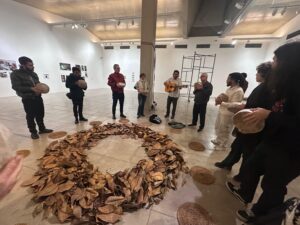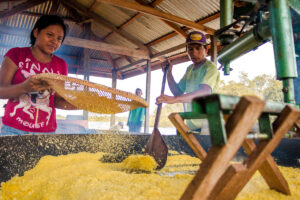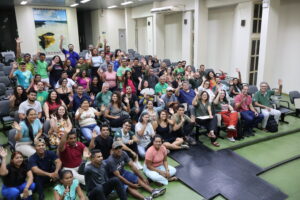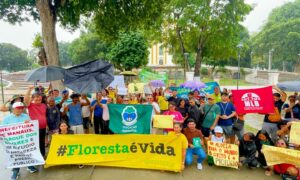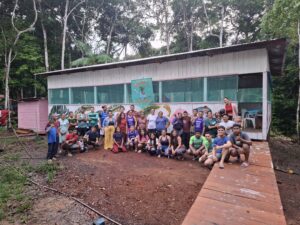Annual gatherings of local organizations strengthen territorial governance, renew leadership, and weave the socio-environmental future of the territory.
By: Nathália Messina
Beneath the green canopy of the Amazon, where the Juruá River winds through traditional communities, a powerful movement is taking shape through the general assemblies of grassroots community associations. From November 2024 to April 2025, the landscape of the middle stretch of the river was energized by the flow of boats, canoes, and motorboats in a convergence of peoples gathering in communion for their assemblies. At least eight such gatherings marked the calendar of the Mid Juruá Territory, bringing together thousands of residents around a common goal: to keep the forest alive and ensure their voices are heard in the pursuit of their demands. Among the assemblies recorded in recent months, we can highlight: AMARU (November 2024), AAEPPRI (December 2025), CODAEMJ (February 2025), AIPOKRU (February 2025), ASMAMJ (March 2025), AMAB (March 2025), ASPROC (April 2025), and AMECSARA (April 2025) — see acronym list below. Instituto Juruá was present at and/or supported all of them.

The General Ordinary Assemblies, such as those held by ASPROC – with the presence of 343 members from 40 different communities – and by CODAEMJ – with 150 cooperatives and participants – are much more than meetings. They are legitimate spaces for dialogue, where citizenship and the foundations of democracy are practiced. Accountability becomes transparency, demands turn into projects, and conflicts have the chance to become consensuses. In these spaces, members decide everything from the renewal of board members to the guidelines for shared management of pirarucu or oilseed harvesting, resources that sustain families and conserve socio-biodiversity.
“The assembly is a way for us to connect with our members, keep our partnerships and transparency in our activities strong; it is a moment for dialogue, learning, and analysis of our growth, both economically and socially“, explains Fernanda Moraes, president of AMAB, the association responsible for the shared management of the Lower Carauari Fishing Agreement. In 2024, the association celebrated its 10th anniversary with a historic assembly at Lago Serrado, reinforcing its role in the protection of managed lakes and in the quality of life of the communities. In 2025, the assembly was attended by more than 140 participants in Bacaba, a community supported by the Carauari City Hall with the construction of a community house to host the assembly and other community meetings.

Photos: Nathália Messina.
Youth and Women: New Perspectives in Community Management and Territorial Governance
Where leadership was once predominantly male, community associations are now revealing important transformations. Women like Fernanda Moraes, president of AMAB, and Maria das Neves Pacheco (Dona Neves), vice president of ASPROC, not only hold leadership positions but also lead projects that are deeply significant for women’s empowerment, community-based economies, family and social bonds, and keeping the forest standing.
ASMAMJ plays a key role in shifting this paradigm — an association created by and for women. In its 2024 assembly, which coincided with the International Women’s Week calendar, ASMAMJ celebrated its 20th anniversary under the theme “Weaving Our Story Together”! In 2025, the association counts 245 members from different communities across the Mid Juruá region — from Baixo Carauari to Baixo Itamarati — and gathered over 200 participants at its latest assembly, which included awareness and educational activities focused on advocating for the rights of women extractivists.
Youth, in turn, often bring renewal: in AMECSARA, socio-environmental projects have encouraged the rise of young leaders in the territory while also reviving ancestral knowledge rooted in local culture. Meanwhile, in AIPOKRU, the newly formed association of the Kulina from the Uerê River, the February assembly elected, for the first time, a leadership board balanced among youth, women, men, and elders — and officially included in its bylaws the requirement that all future boards must have gender parity.
“Our board is made up of women and young people. This is very important for our organization: the strength of youth and the wisdom of women; this is how we will be strong“, says José Paulo Kulina, 33 years old. The Instituto Juruá, through a broad partnership with local associations and other present partners, has been promoting various activities — including training sessions, research, exchanges, and more — to engage this new generation in conservation practices, activism, and shared territorial management.
Beyond the Assemblies: Weaving Networks of Governance
The territory doesn’t move only during the annual assemblies of the associations. The TMJ Forum (Mid Juruá Territory), which brings together local organizations and partners like CNS, ICMBio, and Natura, is an example of how local decisions can gain broader impact.
In parallel, Sectoral Meetings and the Councils of the Conservation Units (CUs) — RESEX Mid Juruá and RDS Uacari — are regularly held by their respective managing associations — ASPROC and AMARU — together with ICMBio and SEMA-AM. These gatherings welcome community demands and help build rules and management strategies for shared-use areas, catalyzing research, projects, and public policies that improve quality of life within the CUs.
Also noteworthy are the meetings of the sociobiodiversity value chains — such as the Pirarucu Lake Management (ASPROC) and the Oilseeds Chain (AMARU and CODAEMJ) — which deepen economic strategies that are closely tied to conservation and to the livelihoods of the managing families.
“Production chains play a central role in territorial governance because, in most cases, they are the final outcome of truly grassroots management of the land. These chains directly connect the way of life of local populations with the protection of the territory and decision-making around its use. When communities manage pirarucu, collect andiroba oil, or harvest açaí, they’re not just generating income for their families — they’re taking real leadership in the stewardship of natural resources. These activities strengthen people’s ties to their territory, create networks of collaboration among communities and institutions, and demand social organization, transparency, and planning. In other words, they give tangible shape to governance, helping to keep the territory alive, productive, and cared for by the very people who inhabit it,” reflects Eduardo Muhlen, Territorial Governance and Socio-Bioeconomy Coordinator at Instituto Juruá. He also adds about the role of local assemblies: “Assemblies are vital moments for the territory. They are times of decision-making, of exercising local leadership, and of celebrating hard-won progress. It’s where people see and hear each other and make collective decisions. In the Mid Juruá, the regular holding of these assemblies has been essential for strengthening and renewing leadership, ensuring accountability, planning actions, and keeping the dialogue alive between communities and organizations. The meetings of the production chains, in turn, have their own strength: they bring together those involved in the management and commercialization of forest and river products. These gatherings allow for the exchange of experiences, assessment of results, adjustments to agreements, and the building of common strategies. Together, assemblies and chain meetings weave the social and political fabric that sustains territorial governance. They ensure that the future of the territory is shaped by the hands of those who live there,” says Eduardo, known to many as Duka.
Challenges and Celebrations: A Territory Reinventing Itself Through Its Own Story
While AMECSARA and ASPROC concluded their assembly cycles in April, marked by the renewal of their boards, AANE is set to resume its assembly in June 2025 to elect a new board in Nova Esperança; meanwhile, ASPODEX is also preparing to celebrate its upcoming assembly in the Deni Indigenous Land of the Xeruã River. Even smaller associations, like AAEPPRI, have been using their assemblies as mechanisms to unite members and validate their strategies—both in the creation of the Itamarati Fishing Agreement, which is expected to be ratified this year, and in strengthening the rubber value chain. AAEPPRI held its first General Assembly after the association’s establishment in December 2024.
Today, the Mid Juruá Territory (TMJ) reveals a strong indicator of territorial governance, promoted by grassroots organizations and their partners. The numbers speak for themselves: over 950 members associated with ASPROC, more than 950 with AMARU, 436 cooperative members with CODAEMJ, 245 with ASMAMJ, and dozens of projects approved collectively this and last year, such as the Mid Juruá Fund (FMJ) and the Mid Juruá Territory Program (PTMJ). When asked about indicators that demonstrate strong governance in the TMJ, Milena Azevedo, from the TMJ Forum Secretariat and AMARU’s administrative team, responded:
“The greatest indicator that governance in the Mid Juruá Territory has shown positive results is undoubtedly the strengthening of social organization and the mobilization of local communities around common goals. The large number of members associated with various organizations, such as ASPROC, AMARU, CODAEMJ, and ASMAMJ, demonstrates an increasing awareness and engagement of the population in issues affecting their territory. Additionally, the significant number of projects approved collectively (…) indicates that the communities are (…) managing to access resources and implement actions that promote sustainable development and the appreciation of the region’s natural resources. This reflects a participatory and effective governance, where community members have a voice in decisions that impact their lives. Another important aspect is the ability to establish partnerships with different actors, such as NGOs, government institutions, and the private sector. This collaborative work strengthens the support network for local initiatives and enhances positive results. In summary, the combination of community organization, approval of collective projects, and strategic partnerships highlights robust territorial governance in the TMJ, which aims not only to address the immediate demands of the population but also to build a more sustainable and just future for all“, explains Milena.
For the Instituto Juruá, supporting these spaces that promote community-based territorial governance, while ensuring the living forest and the quality of life of those who live under it, is investing in the only possible future for the Amazon. The assemblies and community meetings prove that, when communities lead the actions, the forest bears fruit.
While the Mid Juruá prepares for new challenges — such as climate change, land issues, pressure from illegal mining, and the advancement of drug trafficking — one certainty remains: community organizations will continue to be the guiding force for this territory where people and nature coexist in harmony.
*** Learn more about the initiatives of Mid Juruá at:<asproc.org.br>; <amaru-am.com.br>; <codaemj.com.br>; <flordemulateiro.com.br>; <ig @forumtmj> and other partner pages.
Here is your list of abbreviations in English:
AAEPPRI – Association of Environmentalists, Extractivists, Fishermen, and Rural Producers of Itamarati
AGO – General Assembly (Ordinary)
AIPOKRU – Indigenous Association of the Kulina People of the Uere River
AMAB – Association of Agroextractivist Residents of the Lower-Middle Juruá
AMARU – Association of Agroextractivist Residents of the Uacari Sustainable Development Reserve
AMECSARA – Association of Extractivist Residents of São Raimundo Community
ASMAMJ – Association of Agroextractivist Women of the Mid Juruá
ASPODEX – Association of the Deni People of the Xeruã River
ASPROC – Association of Rural Producers of Carauari
CNS – National Council of Extractivist Populations
CODAEMJ – Mixed Cooperative for Sustainable Development and Solidarity Economy of the Mid Juruá
ICMbio – Chico Mendes Institute for Biodiversity Conservation
FMJ – Mid Juruá Fund
Fórum TMJ – Mid Juruá Territory Forum
PTMJ – Mid Juruá Territory Program
RDS Uacari – Uacari Sustainable Development Reserve
RESEX Mid Juruá – Mid Juruá Extractivist Reserve
SEMA-AM – Amazonas State Department of Environment
UC – Conservation Unit

